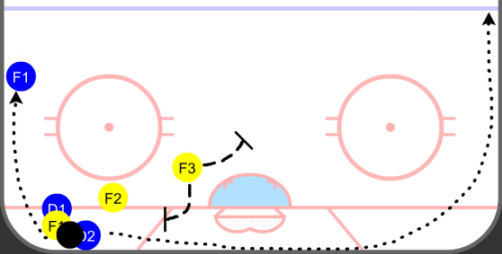Leafs beat reporter Kevin McGran posted this vine video over twitter from a Leafs practice in preparation for the Montreal Canadiens that showed a battle along the boards in what seemed to look like a forechecking exercise. What caught my eye was the way the defense approached the forechecker in the drill.
The vine is here
First man pins, second retrieves RT @kevin_mcgran: Good pace https://t.co/nP8jf8dZ2c
— Gus Katsaros (@KatsHockey) February 28, 2014
Without the benefit of knowing the entire drill, how it started or its main purpose, it’s difficult to gauge whether this is a successful execution or not. The curious element for me was the defensive pin along the boards, at the approach along the boards, prompting my comment to the tweet.
There was a twitter conversation some time ago regarding this as a strategy and it was brought up once again.
@67sound Weren't you talking about "first body, second puck" as a Leafs strat? MT @KatsHockey 1st pins 2nd retrieves https://t.co/4RFMkr8fyR
— Bower Power (@So_Truculent) February 28, 2014
The point of contention was the strategy of being second to the puck, which in logical perspective seems, well, illogical. Defensemen should attempt to pick up possession of the puck and try to move it instead of arriving second upon retrieval.
@So_Truculent @KatsHockey Also, “body first, puck second” makes sense if you're second to the puck.
— 67Sound (@67sound) February 28, 2014
@So_Truculent @KatsHockey My quarrel is with intentionally being second to the puck.
— 67Sound (@67sound) February 28, 2014
Conceptually if the defenseman has time and separation from a forechecker, being first to the puck and start the transition to offense should be the default strategy, moving the puck out of the zone in a controlled exit.
This isn’t always an option, however, particularly in close races, and as a secondary element to limit the physical abuse associated with puck retrieval and taking a hit to make the play – an abuse that can take its toll over the course of a long difficult playoff series and spring run. These situations require a tweak to enhance the possibility of defensemen winning the puck battle and ensuring it is moved out in transition.
There are two keys here to successfully execute this play. First is support. Without proper support, whether from the defensive partner or a forward looping down deep covering up for the partner; this is the primary factor and the play fizzles in its absence. The second is the ability of the defenseman to read the play, analyze and react. Defensemen must make the decision to commit and go for the puck and pin based on factors like support, time available before support arrives, the possibility of being overpowered or angled off the puck, difference in size between pursuers and opposition numbers greater than support numbers.
That’s a lot of information to take in at a glance – and amplifying the necessity to dress smart players with solid hockey IQ’s.
I drew out the play as an animation through the hockeydood app (www.sportsdood.com), and uploaded the video here to show what the play may look like.
I assumed the play was a dump in for the sake of illustration, but this works cleanly with a player entering the zone and being angled wide and into the corner or behind the net down low below the goal line or even in a situation with the puck sent into the corner during a defensive zone scramble. The circumstances likely change with support and number of opposition players on a clean zone entry or applied pressure in the zone, but the play would look similar in nature.
When I wrote about the Leafs defensive zone system, the description was similar to this concept:
Back to the dump in assumption, the puck is sent into the corner and a race is begun for the disk by an opposition forward and a lead defenseman. The defender allows the forward to win the race to the puck, while being within range and keeping pace with the forward to ensure there isn’t a quick pass out front for a play into the slot – especially if there isn’t any support and an opposition forward is lurking into the slot or net zone.
The defender then reaches the puck at the same time as the forward and pins him into the boards, taking him out of the play. There’s no focus on playing the puck, the goal is to isolate and pin the man.
The support player (labeled here as D2, although it could be a support forward) has the responsibility of corralling the puck, reading the play and figuring the options, usually only two. If there’s a clear path up the strong side, the puck is sent up the boards to the high winger that can either chip it out under pressure, or skate it out on his own.
If the strong side isn’t an option, the weak side becomes the default, either as a wrap around the boards and out if there’s opposition pressure, or hopefully a winger is there to get the puck (not pictured).
The play is slightly more complicated on a controlled zone entry, and even more complicated with zone pressure, but the concept is essentially the same. For in zone defensive pressure, isolating the puck carrier happens along the boards and a layered approach of support would follow this type of set up.
Support at the top of the zone to ensure the puck exits is also paramount. A quick transition here could result in an odd man rush the other way if too many opposition forwards are caught in deep looking for pucks.
Watch for the pin and support. It happens a lot.
**********
Follow the McKeen's team on Twitter:
































